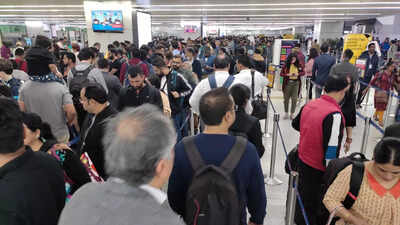Top Searches
- News
- Business News
- India Business News
- Govt reviews congestion at Mumbai & Bengaluru airports; asks operators to balance demand & supply
Govt reviews congestion at Mumbai & Bengaluru airports; asks operators to balance demand & supply

NEW DELHI: The government has turned its attention towards the congestion at Bengaluru and Mumbai airports after considerably easing out the massive problems witnessed at Delhi’s IGIA earlier this month.
Union aviation secretary Rajiv Bansal on Wednesday met the operators of Mumbai — where immigration, especially for international arrivals, is a huge bottleneck — and Bengaluru airports along with senior officials from the Directorate Generals of Civil Aviation (DGCA) and Bureau of Civil Aviation Security (BCAS) to try and ease peak hour congestion at these two hubs.
While sources say Bengaluru’s terminal 2 will become operational in the second fortnight of next month, relief for severely constrained Mumbai Airport in the form of Navi Mumbai Airport is still some years away.
“Airport operators were advised to give daily report on (some) aspects (like) putting sign boards to indicate the real time basis waiting time at entry gates, security lane and also sharing the same through social media feeds. (Inform ministry if) all airlines are manning their check-in counters adequately. Installation of additional x-ray machines to increase the number of security lanes. Rebalancing peak hour flight schedule with the availability of security lanes and disseminating all the relevant information to passengers,” the ministry said in a statement after the meeting.
While details were sought from Mumbai Airport operator and are awaited, at Bengaluru, sources say, more security lanes have been added to match demand and capacity and passengers are being informed about queue times. Once T2 opens, congestion at T1 will reduce.
In a statement, Mumbai Airport International Ltd (MIAL) listed the decongestion steps it has taken. These include: “augmenting manpower resources with the inclusion of ‘passenger service executives’ complemented with infrastructural facilities. Passenger flow and queue monitoring system, a digital tool, (being) to closely monitor passenger footfalls in security processing zone.”
MIAL says terminal operations team have been deployed at pre embarkation security check for security restricted articles removal to reduce the rejection rates at automated tray retrieval system (ATRS).
Staff has been deployed at the end of ATRS machines to ensure quick turnaround for security trays.
“Terminal duty managers are present at security check for managing the queues and prioritise senior citizens and passengers with child in coordination with CISF. Given that immigration and customs are sovereign functions, active on ground coordination is done for queue management and resource mobilisation,” the Adani Group MIAL said, adding, “in the event of sudden passenger surge, passengers are prioritised as per departure timings.”
Th ministry statement says “a few major airports are facing congestion and longer waiting time at various touch points in passenger processing due to increase in number of air travellers on account of seasonal travels. A meeting in this regard was earlier held by Union aviation minister Jyotiraditya Scindia on December 7, directing major airport operators to identify bottlenecks and augment capacity to meet the growing passenger demand.”
“It had come to the notice of the government that a few major airports are facing congestion and longer waiting time at various touch points in passenger processing due to increase in number of air travellers on account of seasonal travels. A meeting in this regard was earlier held by Union aviation minister Jyotiraditya Scindia on December 7, directing major airport operators to identify bottlenecks and augment capacity to meet the growing passenger demand,” the ministry statement added.
On Wednesday, secretary Bansal directed airport operators “to provide requisite facilities commensurate with the growth in number of passengers (and ensure) hassle free travel for air passengers. The airport operators must install additional capacity and redesign their systems and processes, wherever needed to be in readiness for any peak demand scenario.”
The ministry says it is constantly monitoring the situation at major airports and steps being taken to augment capacity. “The situation has improved and is likely to get further eased in coming days,” it added.
Union aviation secretary Rajiv Bansal on Wednesday met the operators of Mumbai — where immigration, especially for international arrivals, is a huge bottleneck — and Bengaluru airports along with senior officials from the Directorate Generals of Civil Aviation (DGCA) and Bureau of Civil Aviation Security (BCAS) to try and ease peak hour congestion at these two hubs.
While sources say Bengaluru’s terminal 2 will become operational in the second fortnight of next month, relief for severely constrained Mumbai Airport in the form of Navi Mumbai Airport is still some years away.
“Airport operators were advised to give daily report on (some) aspects (like) putting sign boards to indicate the real time basis waiting time at entry gates, security lane and also sharing the same through social media feeds. (Inform ministry if) all airlines are manning their check-in counters adequately. Installation of additional x-ray machines to increase the number of security lanes. Rebalancing peak hour flight schedule with the availability of security lanes and disseminating all the relevant information to passengers,” the ministry said in a statement after the meeting.
While details were sought from Mumbai Airport operator and are awaited, at Bengaluru, sources say, more security lanes have been added to match demand and capacity and passengers are being informed about queue times. Once T2 opens, congestion at T1 will reduce.
In a statement, Mumbai Airport International Ltd (MIAL) listed the decongestion steps it has taken. These include: “augmenting manpower resources with the inclusion of ‘passenger service executives’ complemented with infrastructural facilities. Passenger flow and queue monitoring system, a digital tool, (being) to closely monitor passenger footfalls in security processing zone.”
MIAL says terminal operations team have been deployed at pre embarkation security check for security restricted articles removal to reduce the rejection rates at automated tray retrieval system (ATRS).
Staff has been deployed at the end of ATRS machines to ensure quick turnaround for security trays.
“Terminal duty managers are present at security check for managing the queues and prioritise senior citizens and passengers with child in coordination with CISF. Given that immigration and customs are sovereign functions, active on ground coordination is done for queue management and resource mobilisation,” the Adani Group MIAL said, adding, “in the event of sudden passenger surge, passengers are prioritised as per departure timings.”
Th ministry statement says “a few major airports are facing congestion and longer waiting time at various touch points in passenger processing due to increase in number of air travellers on account of seasonal travels. A meeting in this regard was earlier held by Union aviation minister Jyotiraditya Scindia on December 7, directing major airport operators to identify bottlenecks and augment capacity to meet the growing passenger demand.”
“It had come to the notice of the government that a few major airports are facing congestion and longer waiting time at various touch points in passenger processing due to increase in number of air travellers on account of seasonal travels. A meeting in this regard was earlier held by Union aviation minister Jyotiraditya Scindia on December 7, directing major airport operators to identify bottlenecks and augment capacity to meet the growing passenger demand,” the ministry statement added.
On Wednesday, secretary Bansal directed airport operators “to provide requisite facilities commensurate with the growth in number of passengers (and ensure) hassle free travel for air passengers. The airport operators must install additional capacity and redesign their systems and processes, wherever needed to be in readiness for any peak demand scenario.”
The ministry says it is constantly monitoring the situation at major airports and steps being taken to augment capacity. “The situation has improved and is likely to get further eased in coming days,” it added.
FOLLOW US ON SOCIAL MEDIA
FacebookTwitterInstagramKOO APPYOUTUBE
Start a Conversation









